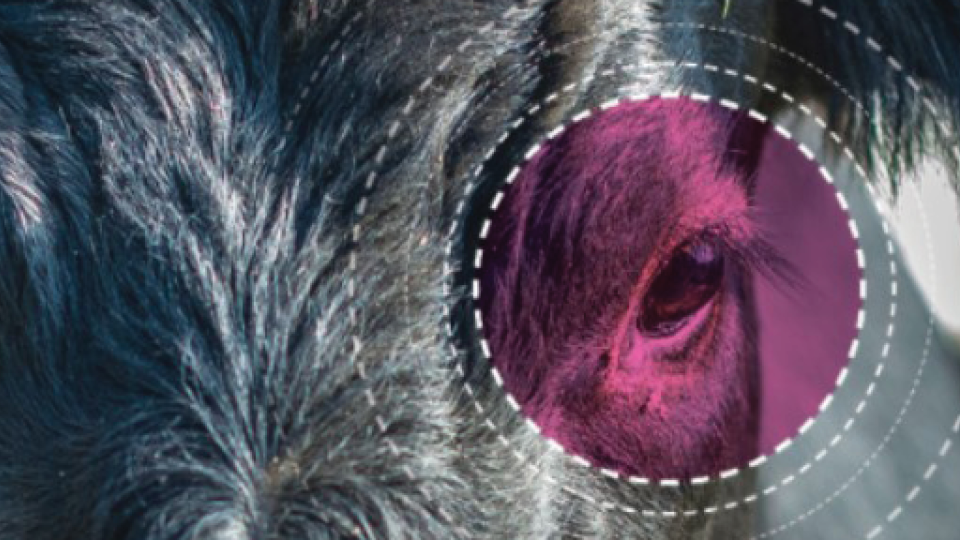Three-prong approach helps put a stop to pinkeye
By Dr. Tim Parks
Producers and veterinarians alike are aware of the challenges that infectious bovine keratoconjunctivitis (IBK) – or pinkeye – presents every year.
Not only does pinkeye cause painful inflammation and lacerations, but it can also be costly to treat and can reduce weaning weight. Because of the disease’s damage and quick ability to spread, it is critical to combat pinkeye as soon as possible if signs appear.
Having a thorough management program in place will help prevent the fast-spreading disease for better cattle health, productivity, and profitability.

Why Pinkeye Persists
Bacteria that cause the disease thrive on the surface of the eye and grow with oxygen and sunlight.
Pinkeye is transferred through direct contact to the pathogen, eye irritants like tall grass, and flies that carry it from cow to cow. Nutritional deficiencies and immune response also play a role in a cow’s ability to overcome the disease.
Lacerated, watery eyes attract face flies that pick up the pathogen and rapidly spread it to other animals. Because warmer weather brings higher fly populations, infection rates increase during the summer and fall seasons.
A solid pinkeye management program should consider how to limit exposure to elements that can damage a cow’s corneal surface and incorporate the three primary tools of controlling pinkeye: vaccination, fly control and environment.
Vaccination
Pinkeye vaccines help limit infection and reduce lesions by stimulating antibody production in eye fluids. Broad-spectrum vaccines are typically effective against a wider variety of infectious pinkeye strains, and it is recommended to vaccinate animals three to six weeks before pinkeye season for the best immune response.
Moraxella bovis is the most common infectious agent found to cause IBK.1 It is critical to understand that M. bovis generally does not cause IBK in the absence of damage to the cornea.
Recently, another bacterium – Moraxella bovoculi – was identified in some outbreaks of IBK. The ability of M. bovoculi to attach to the cornea seems to be rather weak. However, M. bovoculi has spicules that enable it to attach to M. bovis quite well. If M. bovis is attached to the cornea, M. bovoculi often then overgrows the M. bovis. This coinfection scenario means vaccination for both M. bovis and M. bovoculi is important for the most complete prevention strategy.
A recent study found up to 80% of cases include Moraxella bovoculi alone, or along with M. bovis.1 Utilizing Moraxella Bovoculi Bacterin to protect against M. bovoculi, along with other pinkeye solutions, can help ensure maximum protection.
Discuss all vaccination decisions with your veterinarian, who can provide insight into the proper timing and dosing, as well as which product works best in your area.
Fly control
There are several options for external parasite control. With face flies being a major contributing factor to the spread of pinkeye, getting the fly population under control is a critical step in every pinkeye management plan.
While popular fly control methods include fly tags, pour-ons, sprays, dust bags and back rubbers, producers need to choose methods that are effective, long-lasting, and easy to use.
Fly tags protect cattle faces and eyes, with the insecticide placed near those susceptible areas. If using a vaccine that requires a booster, apply fly tags at the same – closer to the start of fly season – time to maximize efficiency. Applying the fly tag too early before fly season impacts the efficacy.
Dust bags and low-volume pour-ons tend to consistently reduce existing fly populations, as do microencapsulated insecticides repeatedly applied around the premises throughout the season.
Pasture and environment
Many environmental factors promote the spread of pinkeye by causing eye irritation and damage, like tall grass, pollen, seed heads, dust, and ultraviolet light.
Keeping pastures trimmed, dust controlled, and direct sunlight limited will minimize these eye irritants. Evaluate areas that could be a breeding ground for flies, like stagnant water, manure, winter hay feeding areas, and silage.
In addition, reducing factors that can cause stress, such as commingling and overcrowding, will help with their overall immunity and ability to fight disease.
Get ahead of pinkeye
Work with your veterinarian to create the best pinkeye management plan for your operation, incorporating the best approaches for fly control, vaccination, and pasture management. Getting your plan of attack in place and implemented will help in maintaining animal health, productivity, and profitability. Learn more at StopCattlePinkeye.com.
References
- Pinkeye in cattle. Mississippi State University Extension Service. POD-02-14.
Find more content for your beef operation.
About the author

Dr. Tim Parks, D.V.M.
Technical Services Manager,
Merck Animal Health
